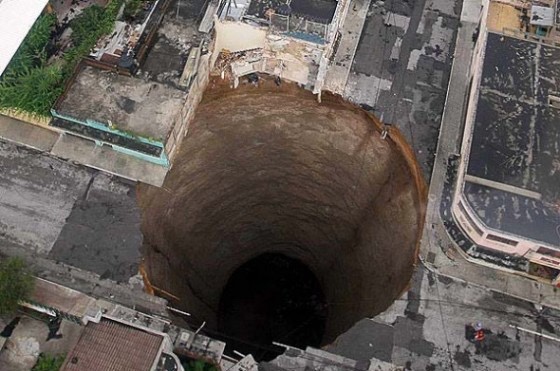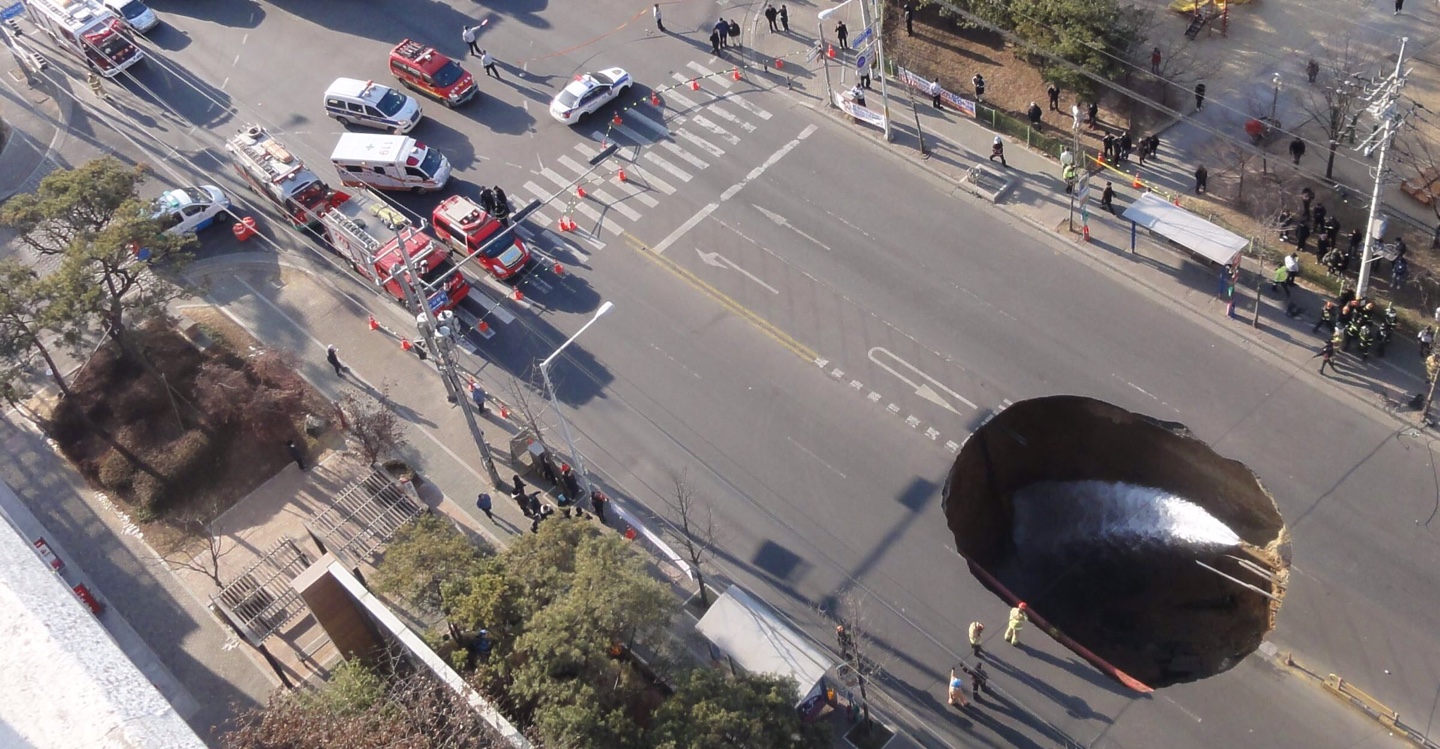Sinkholes usually occur over unstable sedimentary rock regions underground, like limestone caves, causing the ground to collapse above. However, recently they have been appearing in many places around the world, as a result of artificial reasons, such as construction and work underground. On May 20, 2013, a giant sinkhole appeared in China’s Guangdong Province, that measured seven meters in diameter and was four meters deep. The incident caused the death of five workers at a nearby industrial complex. On January 20, 2016, two huge sinkholes appeared on an Oregon State highway in the U.S.A. There were no casualties, but it caused severe traffic congestion. More and more sinkholes are appearing all over the world and we can no longer afford to be complacent about them.
 |
| ▲ The sinkhole in Guatemala (Google) |
The Dankook Herald (DKH) interviewed Kim Du-il, Professor of Civil and Environmental Engineering at Dankook University (DKU), to investigate the causes of sinkholes in detail. “A natural reason for sinkholes is water erosion. As the limestone is eroded by underground water, empty spaces are created underground, causing it to gradually collapse. There are high probabilities for sinkholes in California and Europe because of their common limestone topographies combined with layers of water underground. However, Korea is mostly composed of solid rock, like granite and gneiss, except in Sam-cheok, Gangwon-do, so there is a lower possibility of naturally occurring sinkholes here than in other countries,” he explained.
The DKH asked then why they do occur in the city. “There are three reasons for this. The first one is building construction. When a building is being constructed, it can shake due to the effect of buoyancy caused by underground water. To solve this problem, engineers need to drain the water using a pump and in the process, a waterway is formed, which later becomes a large hole underground. In short, building construction creates sinkholes. The second reason cities see sinkholes is from the construction and operation of an underground subway. For the same reason as with building construction, engineers need to drain the underground water and this again creates a sinkhole. The last manmade reason for sinkholes comes from damaged drain pipes. Poor construction rots underground wood and the surrounding pipes deteriorate. The result is the water leaks out and eventually creates another sinkhole,” he replied.
The extent of the damage depends on the size and birthplace of the sinkhole. Larger sinkholes will see more people suffering from casualties and the loss of property. In August. 2016, a sinkhole that measured ten meters in diameter and three meters deep appeared in China injuring two passersby. Also, in June 2016, there was flood from an exploding water pipe and a gas leak which resulted from a huge sinkhole that appeared in Ottawa, Canada. In other words, sinkholes can cause casualties, as well as material damages to property and personal belongings.
So what can people do to prevent sinkholes? In the U.S.A, the state of Florida set stringent building standards and rules for construction. Sinkholes used to appear frequently in Florida because of its underground water grinding away at the limestone creating empty spaces. To counteract these problems, the state introduced strict construction standards aimed at preventing the further creation of sinkholes. Their efforts have forced people consider the urban water cycle as it relates to the underground water supply. Moreover, they put in place a crisis management team to deal with the risk of sinkholes.
In Korea, there are no special laws or regulations in place to deal with sinkholes, although the government launched a discussion on possible measures to address the matter in 2014. Fortunately, there are few karst caves in Korea and therefore apart from a particular area in the country, people have not seen sinkholes of the magnitude seen in other countries. This does not mean people are safe from the prospect. Last year, a person died in Incheon as a result of a sinkhole and on August 28 2016 another large gap in the ground appeared in Busan. According to the Ministry of Environment, the number of sinkholes in Korea is increasing every year. Research into the causes have been proceeding and a method for inspecting the quality and risk factors underground has been also studied. Finally, The National Research Council of Science & Technology announced that they succeeded in creating a system which can monitor underground utilities. The Electronics and Telecommunications Research Institute (ETRI), The Korean Institute of Construction Technology, and the Korean Institute of Geoscience and Mineral Resources also participated in creating the system. They expect to obtain and to manage information, that would help them better predict sinkholes, but they admit that further study is still needed for precise information.
 |
| ▲ The sinkhole occured in Incheon (Incheon fire station) |
As illustrated above, some countries have already made an effort to reduce the damage caused by sinkholes and this progress is important. These days development tends to make people’s lives more convenient. However, the development sometimes goes too far and causes some bigger problems. Sinkholes are one of them. Some sinkholes result from natural causes, but most them, which occur in the city, are because of too much development and not enough planning management. In those cases, the sinkholes are manmade accidents, not naturally occurring disasters. Therefore, continuous effort is needed to prevent the serious risk of danger associated with the escalating risk of sinkholes in the future.
김강산 , 권유영 dankookherald@gmail.com

![[Campus Magnifier] Let's Surf the Library!](/news/photo/202404/12496_1765_4143.jpg) [Campus Magnifier] Let's Surf the Library!
[Campus Magnifier] Let's Surf the Library!
![[Campus Magnifier] Let's Surf the Library!](/news/thumbnail/202404/12496_1765_4143_v150.jpg)





